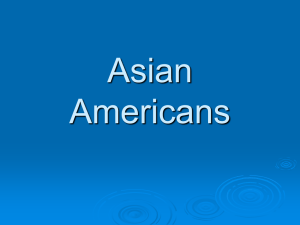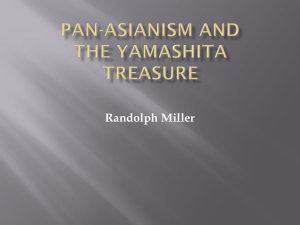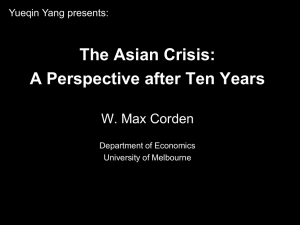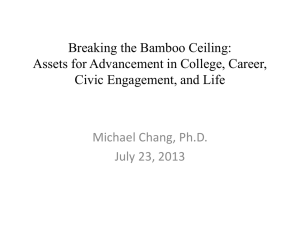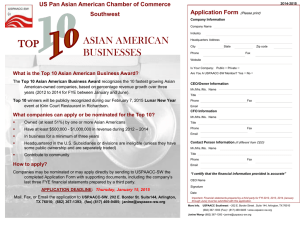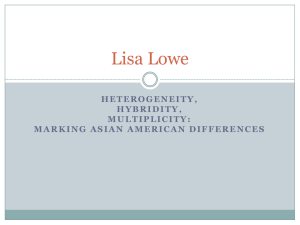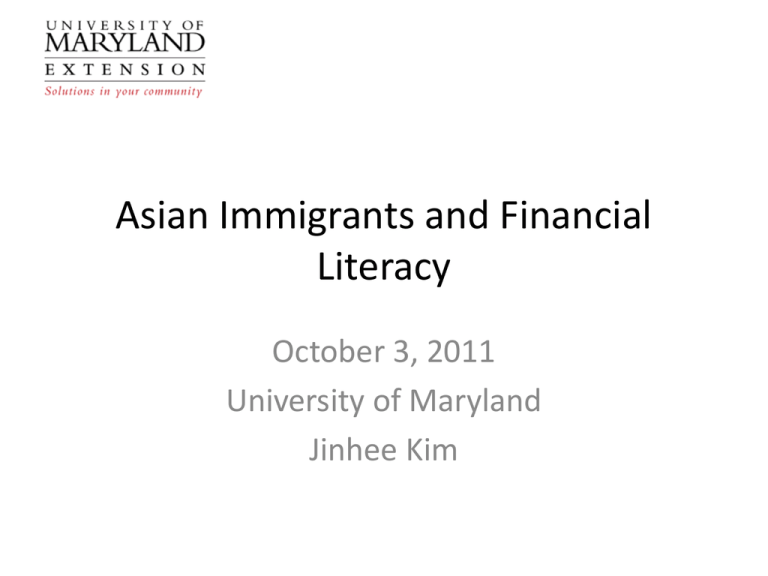
Asian Immigrants and Financial
Literacy
October 3, 2011
University of Maryland
Jinhee Kim
Asian Americans
• Asian descents (immigrants, refugees, and native born)
• 5.6% of population about 17.3 million (2010 Census). One of
the fastest growing minority groups.
• 67% were foreign born (about half them came after 1990)
while a third were native born
• Distinctive culture and language
• Highly concentrated: Half of Asians lived in three states:
California, New York, and Texas (Asians accounted for 43% in
its population in Hawaii and 12% in California)
Asian Immigrants
• East, Southeast, South Asia
Varying ethnic differences: Cultural heritages, economic conditions,
political systems, religious practices, and languages
Country of Origin (Eight-tenths of Asian)
• Chinese-Americans (3.8 million)
• Filipinos (3.2 million)
• Asian Indians (2.8 million)
• Vietnamese (1.7 million)
• Koreans (1.6 million) and Japanese (1.3 million). (Source: 2009
American Community Survey)
• Other ethnic groups include: Bangladesh, Cambodia, Indonesia,
Laos, Malaysia, Myanmar, Nepal, Pakistan, Thailand, and others.
Asian Immigrants
• Stereotype of “model minority” due to higher
socioeconomic status compared to other
minority groups
• Relatively higher education and income on
average
• Ethnic differences (refugees vs. immigrants)
• High average and large dispersion (polarization)
• Higher median income with higher poverty rate
than non-Hispanic white
Education
35
28.9
28.5
30
29.4
25
19.6
20
15
14.714.7
16
20.4
17.6
Total
10.3
10
5
0
Less than
High school
High School Some College
College
Graduate
Asian
Education
80
70
60
Asian Indian
50
Chinese
40
Filipino
30
Japanese
20
Korean
Vietnamese
10
0
< High school
High school
Some college
College and
higher
U.S. Census 2009 American Community Survey
Median Household Income
100000
90429
90000
78028
80000
68780
70000
60000
50000
69211
Total
Asian
64231
5203951840
50221
Asian Indian
Chinese
40000
Filipino
30000
Japanese
20000
Korean
Vietnamese
10000
0
Category 1
Median Income per Capita
45000
35000
30000
39117
37913
40000
29703
26409
Total
31897
28725
Asian
27931
Indian
25000
20794
20000
Chinese
Filipino
15000
Japanese
10000
Korean
Vietnamese
5000
0
Median income per capita
Poverty Rate
16
14
14.9
13.4
13.1
11.8
12
10
Total
White
Asian
9.7
8.8
8.7
8
6
Indian
Chinese
5.2
Filipino
Japanese
4
Korean
2
Vietnamese
0
U.S. Census (2007) The American Community
Employment
Asia
n
(%)
Private
workers
Govn’t
workers
Selfemployed
81.6
Asian
Indian
(%)
85.50
12.3
5.8
Chinese Filipino Japanes Korean
(%)
(%)
e (%)
(%)
80.90
81.30
75.00
78.30
Vietna
mese
(%)
80.70
10.30
13.40
15.50
17.80
9.40
9.20
4.00
5.50
3.10
7.00
11.80
9.70
U.S. Census 2009 American Community Survey
Home Ownership
70
60
50
65.9
63.5
59.4
63.3
64.5
63.7
55.9
Total
48.8
Asian
Indian
40
Chinese
Filipino
30
Japanese
Korean
20
Vietnamese
10
0
U.S. Census 2009 American Community Survey
Home Ownership
Total
Asian
Monthl 37.6%
y
cost/inc
ome
Median 357,100
House
values
($)
Asian
Indian
41.2%
Chinese Filipino Japanes Korean Vietna
e
mese
46.3% 48.1% 39.4% 57.5% 56.2%
360,900 428,600 328,700 408,500 387,300 258,100
U.S. Census 2009 American Community Survey
Length of Stay
80
70
72.1
69
66.8
66.3
74.5
69
72.8
59.8
60
59
58.8 57.8
53.7 52.5
50
40
40.8
Asian
Indian
Chinese
Filipino
30
Japanese
20
Korean
Vietnamese
10
0
Foreign born
Entry since 1990
U.S. Census 2009 American Community Survey
Speak English Less Than “very well”
60
54.8
50
46.1
46
Asian
40
Indian
35.7
Chinese
30
22.2
22.2
24.8
20
Filipino
Japanese
Korean
Vietnamese
10
0
U.S. Census 2009 American Community Survey
Bank Account Ownership
• Rhine and Greene (2006) used Survey of
Income and Program Participation
• Bank account ownership of U.S. immigrants
• Income, net worth, education, family size,
length of stay for Asian’s bank account
ownership
• Overall, Asians seem to integrate into the
financial market in terms of bank account
ownership
Credit
• Avery, Brevoort, and Canner (2009) Federal
Reserve Board
• Recent immigrants had somewhat lower credit
scores than would be implied by their
performance.
• The loan performance of Asians better than the
performance predicted by their credit scores.
Asians paid interest rates that, on average, were
typically lower than, or about the same as, those
paid by non-Hispanic whites across all loan.
Asset Ownership
• Kim, Chatterjee, & Cho (2011) studied home, business,
financial asset ownerships with New Immigrant Survey
• Differences in asset ownership by ethnic groups
• Significantly different by
– Socioeconomic variables: Income and education
– Acculturation: Length of stay and English fluency
– Country of origin: Asian Indian, Korean, Chinese,
Vietnamese, and Philippines
– Demographics: Age, marital status, family size
Financial Literacy Education Resources
for Asians
• FDIC Money Smart:
• The Money Smart for Adults instructor-led
curriculum consists of eleven training modules
that cover basic financial topics.
• The instructor-led version is available in
Chinese, Hmong, Korean, and Vietnamese
CreditSmart Asian
• CreditSmart Asian is a three-part series of multilingual
guidebooks focused on helping Asian Americans
become more informed consumers. Available in
Chinese, Korean, Vietnamese and English, the
guidebooks provide valuable and culturally relevant
information on establishing and maintaining good
credit, the steps to homeownership, and the benefits
and responsibilities of owning a home.
• CreditSmart Freddie Mac
• http://www.freddiemac.com/creditsmart/creditsmart_
asian.html
Visa Asia Pacific MyMoneySkills
• www.MyMoneySkills.com
• Introduced in 2002, this online program offers
six modular topics that cover the most
relevant information needed to meet the daily
financial needs of people of all ages. This
online resource is available in English, Korean,
Thai, Japanese, Bahasa Indonesia, Malay,
Hindi, and Chinese.
Planning for Prosperity: A Financial
Guide for New Asian Americans
• The National Coalition of Asian Pacific American
Community Development (National CAPACD)
and NEFE
• http://nationalcapacd.org/old/NEFE/index.html
• To help Asian immigrants learn how to benefit
from the financial institutions and services in the
United States.
• Its featured information is available in
Cambodian, Chinese, English, Filipino, Hindi,
Hmong, Korean, Samoan, Thai, Urdu and
Vietnamese.
Summary
• Asians are not the same. Many different ethnic groups.
• “Model community?” Higher socioeconomic status on average
with high dispersion.
• Over two thirds are foreign born while half came since 1990.
• New immigrants face challenges in integration into U.S. financial
market.
• Very limited data and research on financial literacy and financial
management of Asian immigrants.
• Some financial literacy education programs translated into Asian
languages are available while a few local communities provide
financial counseling and education programs for Asians.
• Overall, limited resources for financial literacy education. High
average may mask the needs for financial education of many
Asians.
References
• Chatterjee, S. & Kim, J. (2011). Asset ownership of recent immigrants: An
examination of nativity and socioeconomic factors. Migration Letters, 8(2),
141-152.
• Rhine, S. L. W. & Greene, W. H. (2006). The determinants of being
unbanked for U.S. immigrants. Journal of Consumer Affairs, 40(1), 21-40.
• U.S. Census Bureau (2007). The American Community-Asians: 2004.
American Community Survey Reports.
• U.S. Department of Commerce, Economics and Statistics Administration,
U.S. Census Bureau (2010). 2009 American Community Survey 1-year
estimates [Data summary file]. Retrieved from
http://www2.census.gov/acs2009_1yr/prod/SelectPopulationProfile/Unit
ed_States
• U.S. Department of Commerce, Economics and Statistics Administration,
U.S. Census Bureau (2011). 2007 Survey of Business Owners. Retrieved
from http://factfinder.census.gov/servlet/IBQTable?_bm=y&filter=SEX;in;001|RACE_GROUP;in;60,61,62,63,64,65,66,67&-geo_id=D&ds_name=SB0700CSA01&-_lang=en&-fds_name=EC0700A1
Thank you!
• Contact information: jinkim@umd.edu


